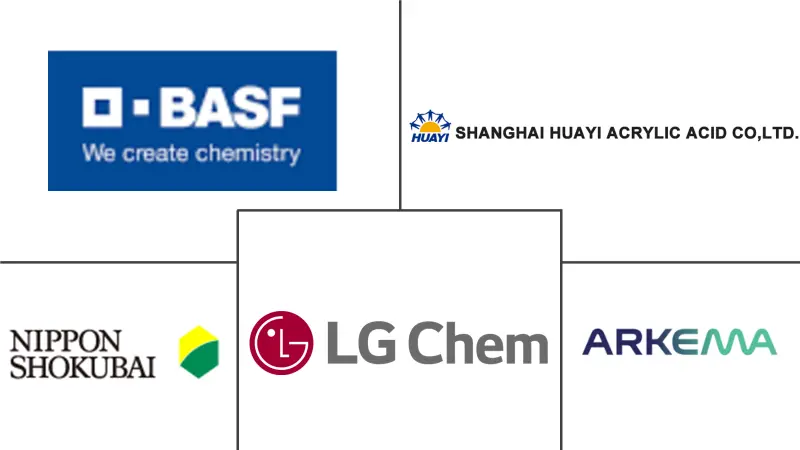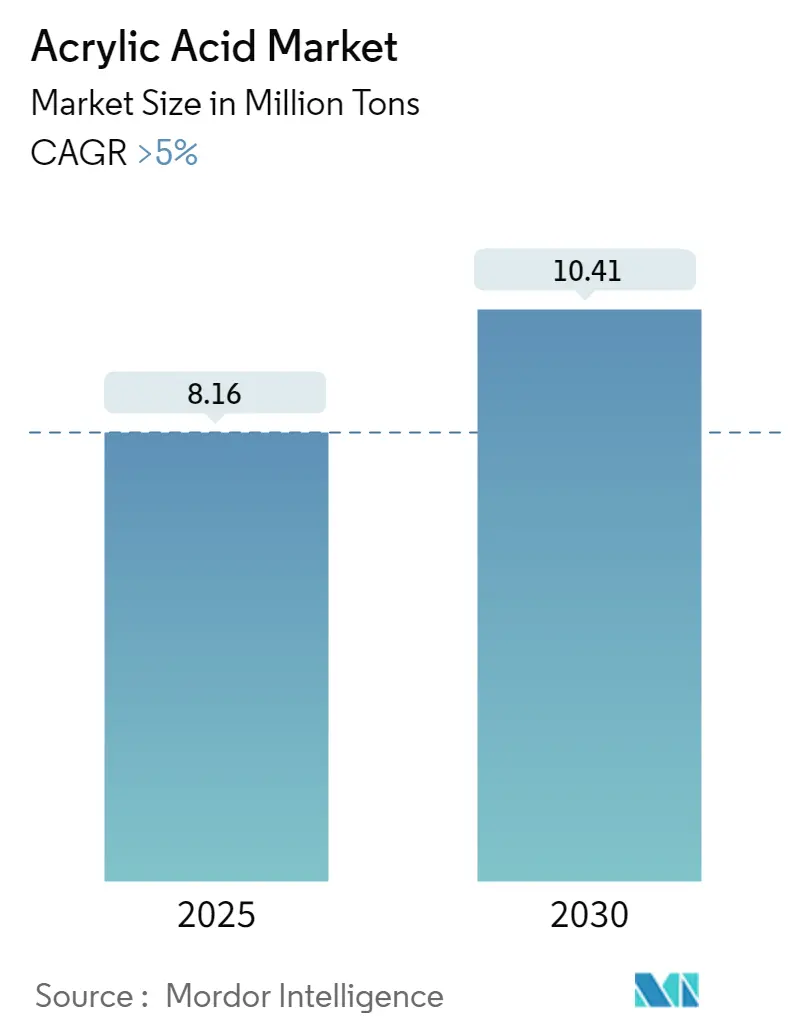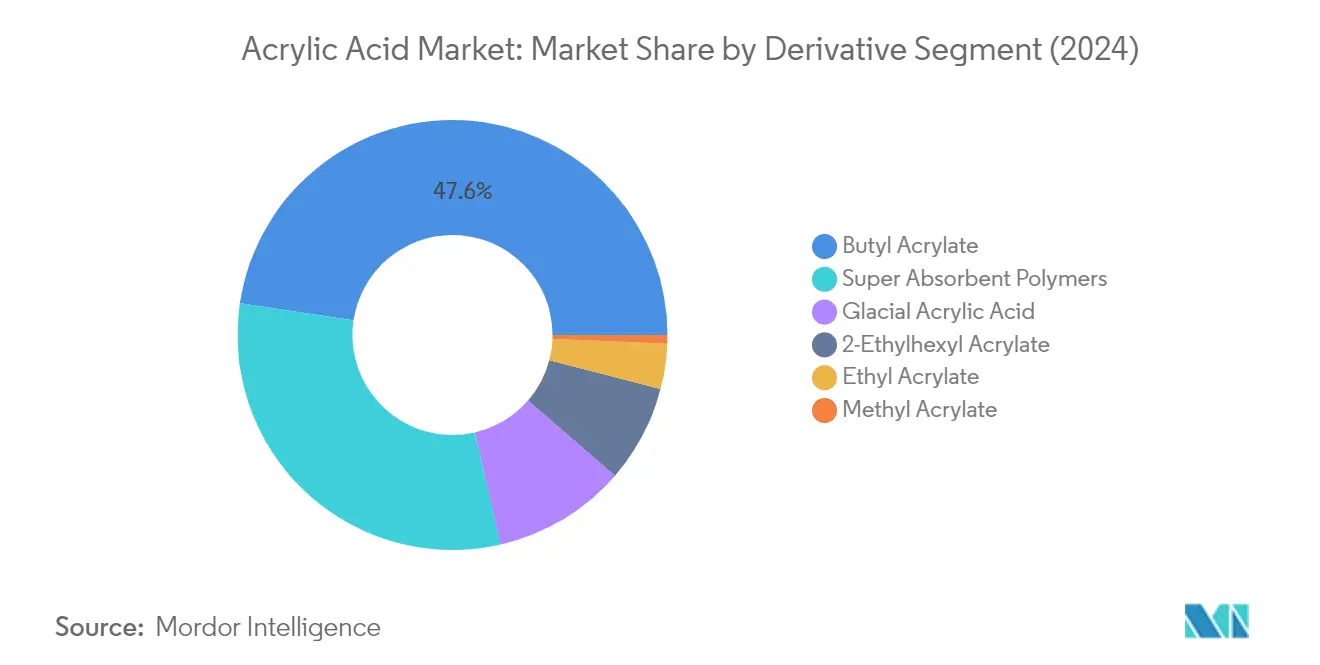Acrylic Acid Market Analysis
The Acrylic Acid Market size is estimated at 8.16 million tons in 2025, and is expected to reach 10.41 million tons by 2030, at a CAGR of greater than 5% during the forecast period (2025-2030).
The acrylic acid industry is experiencing significant transformation driven by evolving end-user demands and technological advancements across multiple sectors. The home and laundry care segment has emerged as a crucial market driver, with the United States alone recording revenue of USD 29.73 billion in 2022, highlighting the growing consumer preference for advanced cleaning solutions. Industrial modernization and increasing urbanization have led to expanded applications in various sectors, including construction, automotive, and consumer goods. The integration of acrylic acid in innovative product formulations has resulted in enhanced performance characteristics, particularly in adhesives, coatings, and textile applications.
The paints and coatings sector continues to be a significant consumer of acrylic acid, with major manufacturers expanding their production capabilities to meet growing acrylic acid demand. In early 2024, PPG Industries announced a significant investment of USD 10 million to expand its OEM coatings production capacity at its Weingarten facility in Germany, demonstrating the industry's commitment to growth. The construction industry's recovery and increasing infrastructure development projects globally have stimulated demand for acrylic acid-based coatings and adhesives. This trend is particularly evident in emerging economies where rapid urbanization and industrial development are driving construction activities.
The textile industry is undergoing substantial changes with new initiatives reshaping market dynamics. In 2023, EURATEX launched the EU-Ukraine Textile Initiative (EUTI), aimed at facilitating cooperation between European and Ukrainian textile companies, creating new opportunities for market expansion and technological collaboration. The initiative represents a significant step toward market integration and technological advancement in the textile sector, where acrylic acid plays a crucial role in fabric treatment and finishing processes. The growing emphasis on sustainable and high-performance textiles has led to increased innovation in acrylic acid applications within this sector.
Recent industry developments indicate a strong focus on capacity expansion and technological advancement. In 2024, Wanhua Chemical Group announced a substantial investment of USD 3.6 billion to build a new chemical complex, significantly expanding its acrylic acid market production capacity. This investment reflects the industry's response to growing demand and the need for more sophisticated production capabilities. The furniture and consumer goods sectors are also driving market growth, with the global furniture market showing robust demand for acrylic-based adhesives and coatings. These developments are accompanied by an increasing focus on sustainable production methods and eco-friendly alternatives, shaping the industry's future direction.
Acrylic Acid Market Trends
INCREASING APPLICATIONS OF SUPER ABSORBENT POLYMERS
The growing adoption of superabsorbent polymers (SAPs) across various applications is driving significant demand for acrylic acid globally. SAPs derived from acrylic acid demonstrate exceptional absorption capabilities, retaining up to 100-1000 times their weight in liquid, making them indispensable in personal hygiene products like baby diapers, adult incontinence products, and feminine hygiene items. This remarkable property, combined with increasing hygiene awareness and government initiatives promoting menstrual health, has led to numerous policy changes worldwide. For instance, in 2023, several governments have implemented programs to provide free menstrual products in schools and public facilities, with countries like New South Wales in Australia committing USD 30 million to ensure access to sanitary products in educational institutions.
The expansion of SAP applications extends beyond personal hygiene into diverse industrial sectors, including agriculture, packaging, and medical applications. SAPs are increasingly utilized in agricultural applications as soil amendments to improve water retention and nutrient delivery in sandy soils, while in the medical sector, they find applications in wound dressings and surgical sponges. The versatility of SAPs has also led to their incorporation in innovative applications such as self-healing concrete, underground power cable protection, and artificial snow production for stage performances. This diversification of applications, coupled with the growing focus on sustainable and efficient water management solutions across industries, continues to drive the demand for acrylic acid as the primary raw material for SAP production.
INCREASING USAGE IN CHEMICAL SYNTHESIS
The versatility of acrylic acid in chemical synthesis has emerged as a crucial driver for market growth, particularly due to its unique ability to undergo both vinyl compound reactions and carboxylic acid reactions. The compound's exceptional reactivity allows it to participate in addition reactions with a wide range of organic and inorganic compounds, making it an invaluable feedstock for producing numerous low molecular compounds and derivatives. In the paints and coatings sector, this versatility is particularly evident, with recent industry data from the American Coatings Association indicating that architectural coatings accounted for 49% of the total market in 2023, while OEM and special-purpose coatings comprised 30% and 21% respectively, demonstrating the broad application spectrum of acrylic acid-based products.
The compound's growing importance in chemical synthesis is further exemplified by its extensive use in producing various derivatives such as acrylate esters, acrylamides, and N-substituted acrylamides. These derivatives find applications across multiple industries, from construction to electronics. The construction sector particularly demonstrates the expanding use of acrylic acid derivatives, with India's construction industry projected to reach USD 1.4 trillion by 2025, driving demand for acrylic-based adhesives, sealants, and coating materials. Additionally, the ability of acrylic acid to copolymerize with various monomers like acrylic and methacrylic esters, vinyl acetate, styrene, and butadiene has led to the development of specialized products with enhanced properties, such as improved weather resistance, flexibility, adhesion, and durability. The price trend of acrylic acid continues to influence the market dynamics, impacting the cost structures across these applications.
Segment Analysis: DERIVATIVE
Butyl Acrylate Segment in Acrylic Acid Market
Butyl acrylate dominates the global acrylic acid market, commanding approximately 48% of the total market share in 2024. This significant market position is attributed to its versatile applications across multiple industries, particularly in the production of homopolymers and copolymers for water-based industrial and architectural paints. The segment's prominence is further strengthened by its crucial role as a "soft-monomer" that enhances low-temperature properties and toughness in various applications. Butyl acrylate's extensive use in water-based industrial paints, cleaning products, antioxidant agents, enamels, adhesives, textiles, caulks, and paper finishes has solidified its position as the leading derivative segment. The double bond reactivity of butyl acrylate also makes it an invaluable chemical intermediary, particularly in the production of poly(butyl acrylate) particles and various block copolymers.
Super Absorbent Polymers Segment in Acrylic Acid Market
The Super Absorbent Polymers (SAP) segment is experiencing the fastest growth in the acrylic acid derivatives market, with an expected growth rate of approximately 6% during 2024-2029. This remarkable growth is driven by increasing applications in personal hygiene products, particularly in baby diapers, adult incontinence products, and feminine hygiene products. The segment's expansion is further supported by its exceptional ability to absorb water up to 100 to 1000 times its own weight, making it indispensable in sanitary and hygiene applications. The growing awareness of hygiene products in emerging economies, coupled with the rising demand for adult incontinence products in developed regions due to aging populations, is fueling this segment's rapid growth. Additionally, the segment is benefiting from technological advancements in SAP manufacturing processes and increasing applications in agriculture and water treatment sectors.
Remaining Segments in Acrylic Acid Derivatives Market
The other significant segments in the acrylic acid derivatives market include Glacial Acrylic Acid, 2-Ethylhexyl Acrylate, Ethyl Acrylate, and Methyl Acrylate, each serving unique industrial applications. Glacial Acrylic Acid plays a vital role in the production of various acrylates and copolymers, while 2-Ethylhexyl Acrylate is crucial in adhesive technologies and coating formulations. Ethyl Acrylate finds extensive applications in polyacrylate elastomers, acrylic rubber, and denture materials. Methyl Acrylate, though smaller in market share, remains important in specialized applications such as fiber modification and organic glass production. These segments collectively contribute to the market's diversity and cater to specific industrial needs across various sectors including textiles, automotive, construction, and consumer goods.
Segment Analysis: APPLICATIONS
Paints and Coatings Segment in Acrylic Acid Market
The paints and coatings segment continues to dominate the global acrylic acid market, holding approximately 38% of the market share in 2024. This significant market position is driven by the extensive use of acrylic acid in architectural coatings, industrial paints, product finishes for original equipment manufacturers including automotive (OEM), and refinishes, as well as special-purpose coatings. The segment's strength is particularly evident in the Asia-Pacific region, where rapid urbanization and infrastructure development have fueled demand. Major paint manufacturers globally are expanding their production capacities, with significant investments in new facilities and technology upgrades. The segment's dominance is further reinforced by acrylic acid's superior properties in coating applications, including excellent stability, strength, and resistance, making it an essential component in both water-borne emulsion paints and solvent-borne paints.
Adhesives and Sealants Segment in Acrylic Acid Market
The adhesives and sealants segment is emerging as the fastest-growing application area in the acrylic acid market, projected to grow at approximately 7% during 2024-2029. This remarkable growth is primarily attributed to the increasing adoption of acrylic-based adhesives across various industries due to their excellent durability, clarity, and color stability. The construction sector is a major driver, with rising demand for concrete bonding agents, tile adhesives, joint fillers, and block adhesives. The segment's growth is further supported by the increased adoption of structural tapes, thermoset hot-melts, and multi-purpose adhesives in green buildings. The packaging industry's expansion, particularly in e-commerce and FMCG sectors, has created substantial demand for acrylic adhesives. Additionally, the automotive and electronics industries are increasingly utilizing specialized acrylic adhesives for their manufacturing processes.
Remaining Segments in Acrylic Acid Applications Market
The other significant segments in the acrylic acid market include sanitary products, surfactants, textiles, and various other applications. The sanitary products segment maintains a strong presence due to the growing demand for superabsorbent polymers in hygiene products. The surfactants segment plays a crucial role in the detergent and cleaning products industry, while the textile segment utilizes acrylic acid for fiber modification and various finishing processes. Other applications include water treatment chemicals, paper processing, and leather treatment. These segments collectively contribute to the market's diversity and stability, with each serving specific industrial needs and contributing to various end-user applications. The continued innovation in these segments, particularly in sustainable and bio-based alternatives, is shaping new opportunities for market growth.
Acrylic Acid Market Geography Segment Analysis
Acrylic Acid Market in Asia-Pacific
The Asia-Pacific region maintains its position as the dominant force in the global acrylic acid market, driven by robust manufacturing capabilities and expanding end-use industries. The region's growth is supported by increasing demand from the paints and coatings, adhesives, textiles, and personal care products sectors. Countries like China, India, Japan, and South Korea are key contributors, with significant investments in production capacity expansion and technological advancements. The presence of major manufacturers and growing industrial activities, particularly in China and India, continue to strengthen the region's market position.
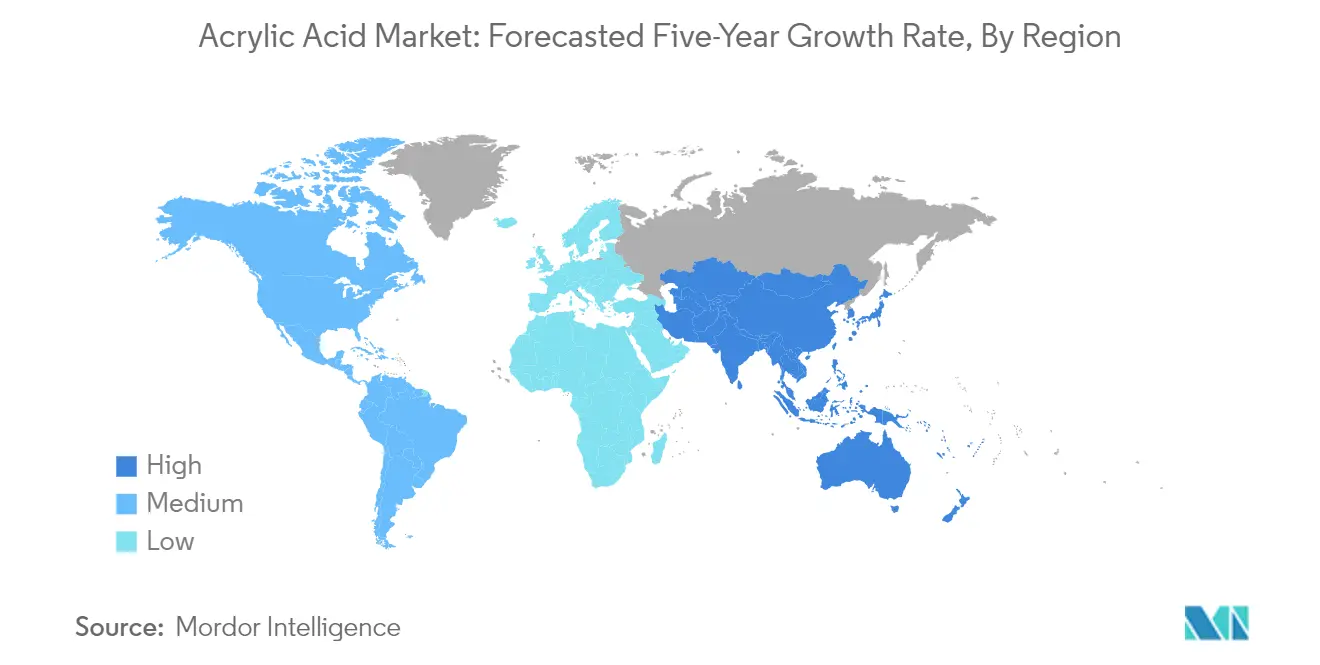
Acrylic Acid Market in China
China dominates the Asia-Pacific acrylic acid market, holding approximately 52% of the regional market share. The country's market leadership is reinforced by its extensive manufacturing infrastructure and growing domestic demand across various end-use industries. China's robust paints and coatings industry, accounting for more than one-fourth of the global coatings market, significantly drives acrylic acid consumption. The country's strong presence in textile manufacturing, being the world's largest textile-producing and exporting nation, further supports market growth. Additionally, China's expanding personal care and hygiene products sector, particularly in baby diapers and feminine hygiene products, continues to boost demand for acrylic acid-based superabsorbent polymers.
Acrylic Acid Market Growth in China
China is experiencing the fastest growth in the Asia-Pacific region, with a projected CAGR of approximately 6% from 2024-2029. The country's growth trajectory is supported by increasing investments in production capacity expansion and technological advancements. The rapid development of end-use industries, particularly in the construction and automotive sectors, drives the demand for acrylic acid-based products. China's focus on domestic manufacturing capabilities and the government's support for industrial development continue to create favorable conditions for market expansion. The country's growing emphasis on sustainable and high-performance materials in various applications further accelerates market growth.
Acrylic Acid Market in North America
North America represents a significant market for acrylic acid, characterized by advanced manufacturing capabilities and high demand from diverse end-use industries. The region's market is driven by a strong presence in the paints and coatings, adhesives, and personal care products sectors. The United States, Canada, and Mexico form the key markets, with each country contributing uniquely to the regional demand. The region's focus on technological advancement and sustainable production methods continues to shape market development.
Acrylic Acid Market in United States
The United States leads the North American market, commanding approximately 83% of the regional market share. The country's dominant position is supported by its advanced manufacturing infrastructure and strong presence of major industry players. The robust paints and coatings industry, contributing significantly to the global market, drives substantial demand for acrylic acid. The country's well-established personal care and hygiene products sector, coupled with growing demand for superabsorbent polymers in various applications, further strengthens market growth. The presence of key manufacturers and ongoing investments in research and development continue to reinforce the United States' market leadership.
Acrylic Acid Market Growth in Mexico
Mexico emerges as the fastest-growing market in North America, with an expected CAGR of approximately 4% from 2024-2029. The country's growth is driven by increasing industrialization and growing demand from various end-use sectors. Mexico's strategic position as a manufacturing hub, particularly in the automotive and construction industries, contributes to rising demand for acrylic acid-based products. The country's expanding textile industry and growing focus on personal care products further support market growth. Additionally, Mexico's favorable business environment and increasing investments in manufacturing capabilities continue to attract industry players.
Acrylic Acid Market in Europe
Europe maintains a strong position in the global acrylic acid market, supported by its advanced manufacturing capabilities and innovative technological developments. The region's market is characterized by a strong presence in high-value applications and a focus on sustainable production methods. Key markets including Germany, France, the United Kingdom, and Italy demonstrate varied growth patterns influenced by their industrial strengths and economic conditions. The region's emphasis on environmental regulations and sustainable practices continues to influence market development.
Acrylic Acid Market in Germany
Germany stands as the largest market for acrylic acid in Europe, with its strong industrial base and technological expertise. The country's leadership in chemical manufacturing and the presence of major industry players contribute significantly to market growth. Germany's robust automotive and construction sectors drive substantial demand for acrylic acid-based products. The country's advanced research and development capabilities, coupled with a focus on innovative applications, maintain its market leadership position.
Acrylic Acid Market Growth in Germany
Germany also leads in terms of market growth in Europe, demonstrating strong development across various applications. The country's market expansion is driven by increasing demand from diverse end-use industries and ongoing technological advancements. Germany's focus on sustainable production methods and bio-based alternatives creates new growth opportunities. The country's strong manufacturing infrastructure and continued investments in capacity expansion support market development.
Acrylic Acid Market in South America
The South American acrylic acid market demonstrates steady growth potential, driven by increasing industrialization and growing demand from end-use sectors. Brazil and Argentina represent the key markets in the region, with Brazil emerging as both the largest and fastest-growing market. The region's market development is supported by expanding manufacturing capabilities and growing demand from the construction, textile, and personal care sectors. The presence of major manufacturers and increasing investments in production capacity contribute to market growth.
Acrylic Acid Market in Middle East & Africa
The Middle East & Africa region shows promising growth in the acrylic acid market, supported by increasing industrialization and infrastructure development. The region's market is characterized by growing demand from the construction, textile, and personal care sectors. South Africa represents the largest market, while Saudi Arabia demonstrates the fastest growth rate. The region's market development is driven by expanding manufacturing capabilities and increasing investments in production infrastructure. Growing emphasis on domestic production capabilities and rising demand from various end-use industries continue to shape market growth.
Acrylic Acid Industry Overview
Top Companies in Acrylic Acid Market
The global acrylic acid market is dominated by major chemical conglomerates that have established strong manufacturing and distribution networks worldwide. These industry leaders are actively pursuing capacity expansions, particularly in high-growth regions like Asia-Pacific, to meet increasing demand from end-use industries. Companies are investing significantly in research and development to develop bio-based alternatives and improve production efficiency through technological innovations. Strategic collaborations and joint ventures, especially in emerging markets, have become increasingly common as companies seek to strengthen their market positions. Operational agility has become crucial, with manufacturers focusing on waste reduction, material usage optimization, and sustainable production practices to maintain competitive advantages. The industry has also witnessed a trend toward vertical integration, with major players expanding their presence across the value chain from raw materials to end products.
Consolidated Market with Strong Regional Players
The acrylic acid market exhibits a highly consolidated structure, with the top five players controlling a significant portion of global production capacity. These market leaders are predominantly large chemical conglomerates with diverse product portfolios and strong financial capabilities, allowing them to invest in capacity expansions and technological advancements. Regional players, particularly in Asia-Pacific, have emerged as formidable competitors by leveraging local market knowledge and establishing strong relationships with end-users. The market has witnessed strategic partnerships and joint ventures between global and local players to enhance market penetration and optimize distribution networks. Manufacturing facilities are strategically located near raw material sources or key consumption centers to ensure cost competitiveness and reliable supply.
The industry landscape is characterized by high entry barriers due to significant capital requirements, technical expertise needs, and stringent regulatory compliance standards. Mergers and acquisitions have been primarily focused on vertical integration and geographic expansion, particularly in emerging markets. Companies are increasingly adopting long-term contract-based relationships with key customers to ensure stable demand and mitigate price volatility risks. The market also sees strong backward integration with propylene suppliers, as raw material availability and cost play crucial roles in determining competitive positions.
Innovation and Sustainability Drive Future Growth
Success in the acrylic acid industry increasingly depends on companies' ability to develop sustainable production processes and bio-based alternatives while maintaining cost competitiveness. Market leaders are investing in research and development to improve production efficiency and reduce environmental impact, while also expanding their product portfolios to meet evolving customer needs. Strategic location of production facilities, strong distribution networks, and vertical integration have become critical factors for maintaining market share. Companies are also focusing on developing closer relationships with end-users through technical support and customized solutions, while maintaining flexibility in pricing strategies to respond to market dynamics.
For new entrants and smaller players, success lies in identifying and serving niche market segments or specific geographic regions where they can establish strong positions. Building strategic partnerships with raw material suppliers and end-users, investing in innovative technologies, and focusing on sustainability initiatives are crucial for gaining market share. The industry faces increasing regulatory pressure regarding environmental impact and safety standards, making compliance capabilities a key differentiator. End-user industries' consolidation and their growing preference for suppliers who can provide comprehensive solutions and consistent quality are shaping competitive strategies. Companies must also maintain robust risk management practices to handle raw material price volatility and changing market dynamics.
Acrylic Acid Market Leaders
-
BASF SE
-
Arkema
-
LG Chem
-
Shanghai Huayi Acrylic Acid Co. Ltd.
-
NIPPON SHOKUBAI CO., LTD.
- *Disclaimer: Major Players sorted in no particular order
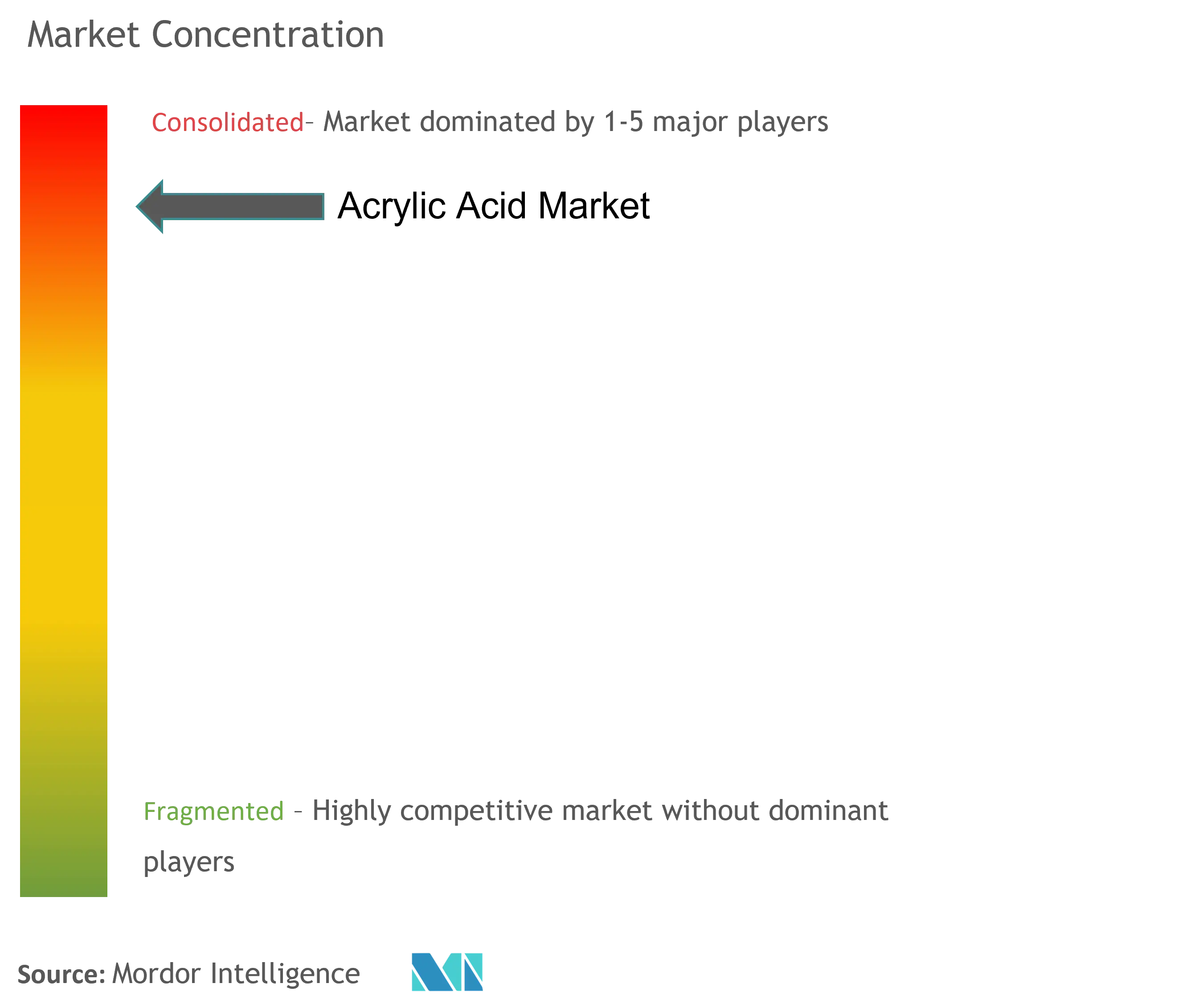
Acrylic Acid Market News
- January 2024: Arkema announced that it obtained ISCC+ certification for its acrylic acid and ester production facility located in Taixing, Jiangsu Province, China, as a step in decarbonizing its acrylic production chain.
- May 2023: NIPPON SHOKUBAI CO. LTD announced that its subsidiary, PT. NIPPON SHOKUBAI, Indonesia, inaugurated its new acrylic acid facility with an annual production capacity of 100,000 metric tonnes in Cilegon, Banten, Indonesia.
- March 2023: BASF SE broke ground on an acrylic acid complex at the Zhanjiang Verbund site in China. The complex includes plants for glacial acrylic acid (GAA), butyl acrylate (BA), and 2-ethylhexyl acrylate (2-EHA). The complex will have an annual production capacity of approximately 400,000 metric tons of BA and 100,000 metric tons of 2-EHA.
- February 2023: NIPPON SHOKUBAI CO. LTD acquired ISCC PLUS certification for 19 products, including acrylic acid, superabsorbent polymers, and ethylene oxide, which are produced at its Himeji Plant and Kawasaki Plant. The certification allows the promotion of biomass as raw materials for disposable diapers, detergents, and other products.
Acrylic Acid Market Report - Table of Contents
1. INTRODUCTION
- 1.1 Study Assumptions
- 1.2 Scope of the Study
2. RESEARCH METHODOLOGY
3. EXECUTIVE SUMMARY
4. MARKET DYNAMICS
-
4.1 Drivers
- 4.1.1 Increasing Applications of Super Absorbent Polymers
- 4.1.2 Increasing Usage in Chemical Synthesis
-
4.2 Restraints
- 4.2.1 Health Hazards of Acrylic Acid
- 4.3 Industry Value Chain Analysis
-
4.4 Porter's Five Forces Analysis
- 4.4.1 Bargaining Power of Suppliers
- 4.4.2 Bargaining Power of Buyers
- 4.4.3 Threat of New Entrants
- 4.4.4 Threat of Substitute Products and Services
- 4.4.5 Degree of Competition
5. MARKET SEGMENTATION (Market Size in Volume)
-
5.1 By Derivative
- 5.1.1 Methyl Acrylate
- 5.1.2 Butyl Acrylate
- 5.1.3 Ethyl Acrylate
- 5.1.4 2-Ethylhexyl Acrylate
- 5.1.5 Glacial Acrylic Acid
- 5.1.6 Superabsorbent Polymer
-
5.2 By Application
- 5.2.1 Paints and Coatings
- 5.2.2 Adhesives and Sealants
- 5.2.3 Surfactants
- 5.2.4 Sanitary Products
- 5.2.5 Textiles
- 5.2.6 Other Applications
-
5.3 By Geography
- 5.3.1 Asia-Pacific
- 5.3.1.1 China
- 5.3.1.2 India
- 5.3.1.3 Japan
- 5.3.1.4 South Korea
- 5.3.1.5 Malaysia
- 5.3.1.6 Thailand
- 5.3.1.7 Indonesia
- 5.3.1.8 Vietnam
- 5.3.1.9 Rest of Asia-Pacific
- 5.3.2 North America
- 5.3.2.1 United States
- 5.3.2.2 Canada
- 5.3.2.3 Mexico
- 5.3.3 Europe
- 5.3.3.1 Germany
- 5.3.3.2 United Kingdom
- 5.3.3.3 France
- 5.3.3.4 Italy
- 5.3.3.5 Spain
- 5.3.3.6 NORDIC Countries
- 5.3.3.7 Turkey
- 5.3.3.8 Russia
- 5.3.3.9 Rest of Europe
- 5.3.4 South America
- 5.3.4.1 Brazil
- 5.3.4.2 Argentina
- 5.3.4.3 Colombia
- 5.3.4.4 Rest of South America
- 5.3.5 Middle East and Africa
- 5.3.5.1 Saudi Arabia
- 5.3.5.2 Qatar
- 5.3.5.3 United Arab Emirates
- 5.3.5.4 Nigeria
- 5.3.5.5 Egypt
- 5.3.5.6 South Africa
- 5.3.5.7 Rest of the Middle East and Africa
6. COMPETITIVE LANDSCAPE
- 6.1 Mergers, Acquisitions, Joint Ventures, Collaborations, and Agreements
- 6.2 Market Share (%) Analysis
- 6.3 Strategies Adopted by Leading Players
-
6.4 Company Profiles
- 6.4.1 Arkema
- 6.4.2 BASF SE
- 6.4.3 China Petroleum & Chemical Corporation (SINOPEC)
- 6.4.4 Dow
- 6.4.5 Formosa Plastics Corporation
- 6.4.6 LG Chem
- 6.4.7 Merck KGaA
- 6.4.8 Mitsubishi Chemical Corporation
- 6.4.9 NIPPON SHOKUBAI CO. LTD
- 6.4.10 Sasol
- 6.4.11 Shanghai Huayi Acrylic Acid Co. Ltd
- 6.4.12 Satellite Chemical Co. Ltd
- 6.4.13 Wanhua
- *List Not Exhaustive
7. MARKET OPPORTUNITIES AND FUTURE TRENDS
- 7.1 Increasing Demand for Bio-based Polymers
Acrylic Acid Industry Segmentation
Acrylic acid is a colorless, unsaturated carboxylic acid with the molecular formula C3H4O2, produced through the two-stage catalytic oxidation of propylene. It can be polymerized to form homopolymers and copolymerized with esters and other vinyl monomers. Thus, acrylic acid is mainly used to produce polymers for different plastic products. It can also be used to produce adhesives, sealants, and surfactants.
The acrylic acid market is segmented by derivative, application, and geography. By derivative, the market is segmented into methyl acrylate, butyl acrylate, ethyl acrylate, 2-ethylhexyl acrylate, glacial acrylic acid, and superabsorbent polymer. By application, the market is segmented into paints and coatings, adhesives and sealants, surfactants, sanitary products, textiles, and other applications (consumer goods, etc.) The report also covers the market sizes and forecasts in 15 countries across major regions. The market sizes and forecasts are provided in terms of volume (tons) for all the above segments.
| By Derivative | Methyl Acrylate | ||
| Butyl Acrylate | |||
| Ethyl Acrylate | |||
| 2-Ethylhexyl Acrylate | |||
| Glacial Acrylic Acid | |||
| Superabsorbent Polymer | |||
| By Application | Paints and Coatings | ||
| Adhesives and Sealants | |||
| Surfactants | |||
| Sanitary Products | |||
| Textiles | |||
| Other Applications | |||
| By Geography | Asia-Pacific | China | |
| India | |||
| Japan | |||
| South Korea | |||
| Malaysia | |||
| Thailand | |||
| Indonesia | |||
| Vietnam | |||
| Rest of Asia-Pacific | |||
| North America | United States | ||
| Canada | |||
| Mexico | |||
| Europe | Germany | ||
| United Kingdom | |||
| France | |||
| Italy | |||
| Spain | |||
| NORDIC Countries | |||
| Turkey | |||
| Russia | |||
| Rest of Europe | |||
| South America | Brazil | ||
| Argentina | |||
| Colombia | |||
| Rest of South America | |||
| Middle East and Africa | Saudi Arabia | ||
| Qatar | |||
| United Arab Emirates | |||
| Nigeria | |||
| Egypt | |||
| South Africa | |||
| Rest of the Middle East and Africa | |||
Acrylic Acid Market Research FAQs
How big is the Acrylic Acid Market?
The Acrylic Acid Market size is expected to reach 8.16 million tons in 2025 and grow at a CAGR of greater than 5% to reach 10.41 million tons by 2030.
What is the current Acrylic Acid Market size?
In 2025, the Acrylic Acid Market size is expected to reach 8.16 million tons.
Who are the key players in Acrylic Acid Market?
BASF SE, Arkema, LG Chem, Shanghai Huayi Acrylic Acid Co. Ltd. and NIPPON SHOKUBAI CO., LTD. are the major companies operating in the Acrylic Acid Market.
Which is the fastest growing region in Acrylic Acid Market?
Asia Pacific is estimated to grow at the highest CAGR over the forecast period (2025-2030).
Which region has the biggest share in Acrylic Acid Market?
In 2025, the Asia Pacific accounts for the largest market share in Acrylic Acid Market.
What years does this Acrylic Acid Market cover, and what was the market size in 2024?
In 2024, the Acrylic Acid Market size was estimated at 7.75 million tons. The report covers the Acrylic Acid Market historical market size for years: 2024. The report also forecasts the Acrylic Acid Market size for years: 2025, 2026, 2027, 2028, 2029 and 2030.
Our Best Selling Reports
Acrylic Acid Market Research
Mordor Intelligence delivers a comprehensive analysis of the acrylic acid market, leveraging decades of expertise in the chemical industry. Our research thoroughly examines propenoic acid, also known as acrylic acid, and its derivatives. These include glacial acrylic acid and bio acrylic acid applications. The report provides detailed insights into acrylic acid prices and price trends. It also analyzes the growing demand for isobutyl acrylate and methacrylic acid across global markets.
Our detailed market analysis benefits stakeholders by offering crucial insights into acrylic acid industry dynamics and emerging opportunities. The report examines the market size for acrylic acid across different regions. This analysis is supported by extensive primary research and statistical data. Stakeholders can access our findings through an easy-to-download report PDF format. It features comprehensive data on acrylic acid demand patterns, production costs, and future growth projections. The analysis includes valuable information about technological advancements and regulatory frameworks affecting market development.

